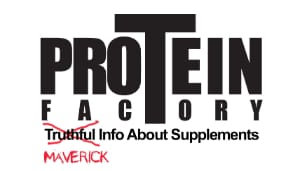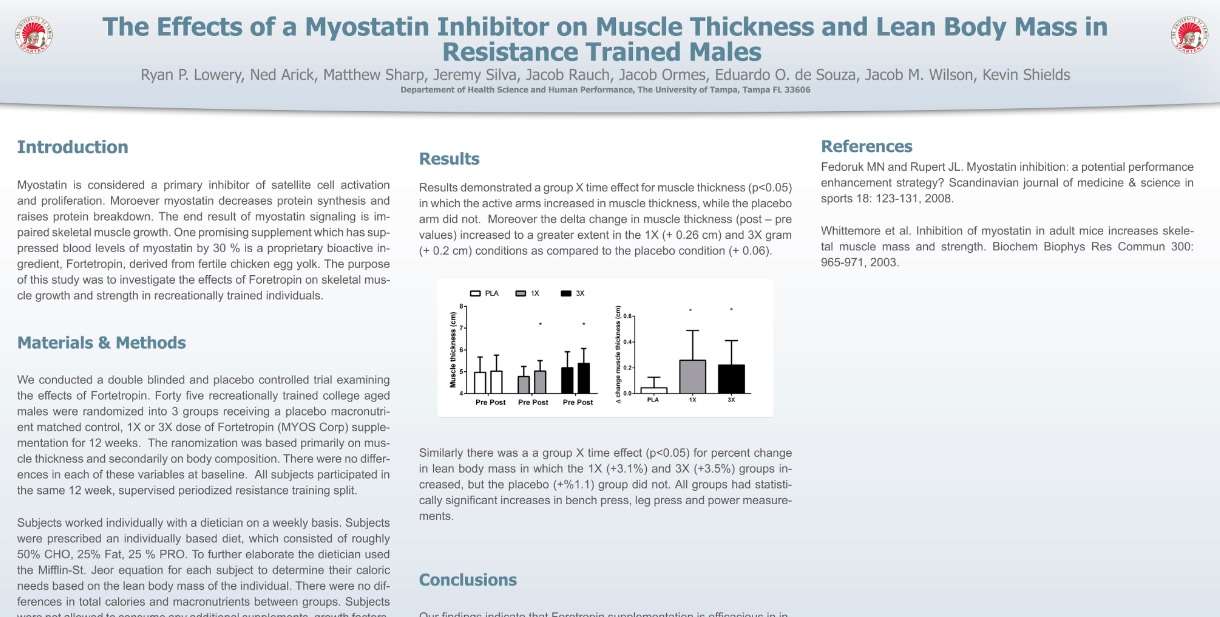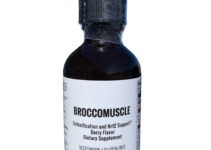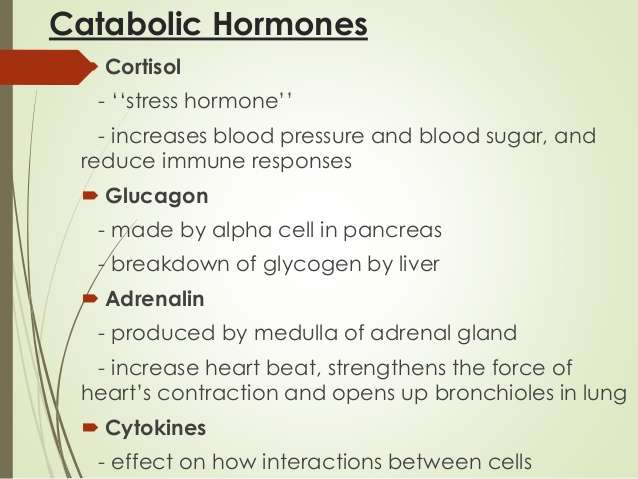Many people today are still looking for a myostatin supplement. However there is only one that truly reduces myostatin in the body, and the product is called Myo-X from MHP. Myo-X contains an ingredient from the MYOS RENS corporation that is patented. The patent can be found here. Myo-X is actually egg yolk powder. However it is a very special egg yolk powder. The egg yolk powder actually contains active follistatin. If you have been reading about myostatin you’ll know that follistatin can reduce myostatin. Many studies have shown this to be true. The creator of the world’s only myostatin inhibitor supplement was Dr. Carlon Colker. Dr. Colker first came up with the idea to use fertile egg yolks and test it on humans to see if the follistatin was still active in their bodies. After Dr. Colker figured about that if people consumed egg yolks with follistatin in them and consumed them, would this reduce myostatin in the body.
You can find Dr. Colkers work below.
This product which is now owned by MYOS REN corp is the only legitimate myostatin supplement. You can find a few myostatin supplements here and there, but most of them are just unproven, un-researched supplements. Fertile egg yolk powder, produced by this patented process, does indeed contain active follistatin. The research that MYOS RENS has completed does indeed show that taking their product will reduce myostatin.
The question remains however, will consuming this myostatin supplement actually build muscle mass? I believe that this myostatin supplement is more of an anti-catabolic supplement and not an anabolic one. If you Google myostatin you’ll see a ton of pictures of cows with massive muscle mass or dogs that have extreme muscle mass. This will NOT happen by consuming fertile egg yolk powder with active follistatin. Instead I think the best results you’ll have with a myostatin supplement is that you will NOT lose the muscle mass you have gained at the gym. You’ll be anti-catabolic.
Who’s this product for?
I believe that people looking to lose weight or body fat can benefit from this myostatin supplement. When you want to lose weight you need to reduce your calories which means you’ll be in a catabolic state often. Therefore you want to use food, life style, and supplements to be anti-catabolic. This is where Myo-X comes into play. In addition things like protein powders which contain high amounts of BCAA’s such as whey and egg will help.
When to use it? There is no particular time you need to consume Myo-X. You can use it anytime you want.
Avoid cafffeine and other stimulants when using Myo-X. Caffeine is a catabolic agent and will increase catabolic activity in your body. This will be counter-productive when using Myo-X.
Remember, Myo-X (myostatin supplement) is the only legitimate follistatin containing natural supplement in the world. It is patented. I have see other egg yolk powder follistatin claming supplements out there. These are all a scam.
| Colker C, Randomized blind comparison of follistatin in standard store-bought unfertilized chicken eggs verses standard store-bought fertile eggs. Reviewed and accepted for presentation at the 2006 Annual Meeting of the American College of Nutrition and abstract publication in Journal of the American College of Nutrition, Volume 25, No.5, Abstract 65; October 2006. |
| RANDOMIZED BLIND COMPARISON OF FOLLISTATIN IN STANDARD STORE-BOUGHT UNFERTILIZED CHICKEN EGGS VERSES STANDARD STORE-BOUGHT FERTILE EGGS Colker, C. Peak Wellness, Inc., Greenwich, CT Both standard store bought chicken eggs and fertile chicken eggs have long been available for mass consumption and traditionally believed by experts and the USDA to be no different in nutritive value (www.fsis.usda.gov/OA/pubs/shelleggs.htm) Nevertheless, a significant number of people maintain the belief that the fertile egg offers a holistic and/or possibly a nutritional advantage. Thus fertile eggs have long since been available to the consumer in order to satisfy this demand. Though minor contrasts have been cited, until this study, no significant hormonal differences had been identified. In this randomized, blinded comparison of the two egg types, 6 standard grade A store bought eggs were tested. Of these 4 were fertile (New England Produce Center Brand purchased at Stop & Shop, Port Chester, New York) and 2 unfertilized (Stop & Shop Brand purchased at Stop & Shop, Port Chester, New York). Follistatin levels were qualitatively and quantitatively determined via immobilizing follistatin by binding to Activin in a C18 HPLC column (ExperTox, Inc., Deer Park, Texas). The assay was standardized with Recombinant Follistatin 288 and was assayed in an LC/MS with a third degree fragmentation (D.S., Tanetta, et al, 1977). Results revealed that all 4 fertile egg samples contained significant concentrations of follistatin (0.11, 1.05. 0.67. and 0.81 mcg/mg), while the 2 unfertilized eggs contained no detectable follistatin (0 and 0 mcg/mg). These results clearly contradict what was the preexisting conventional wisdom of what we thought we knew about commercially available eggs. Further studies need to reveal the role and the advantages, if any, of having greater amounts of follistatin in the diet. |
| Colker C, Absorption profile and hormonal influences of fertile egg yolk ingestion in the human. Reviewed and accepted for presentation at the 2006 Annual Meeting of the American College of Nutrition and abstract publication in Journal of the American College of Nutrition, Volume 25, No.5, Abstract 66; October 2006. |
| ABSORPTION PROFILE AND HORMONAL INFLUENCES OF FERTILE EGG YOLK INGESTION IN THE HUMAN Colker, C. Peak Wellness, Inc., Greenwich, CT Fertile egg yolks contain significant concentrations of follistatin. In an effort to identify whether this orally ingested source of naturally occurring follistatin is actually absorbed and pharmaco-kinetically active in the human model, this study was undertaken. A male subject was chosen because the normal baseline male physiology does not regularly contain any measurable concentration of follistatin. Follistatin-rich fertile egg yolk powder properly processed to preserve active follistatin (FolstaxanTM) was obtained (Celldyne Biopharma, San Antonio, TX). After initial blood draw and subsequent oral FolstaxanTM dosing, serum follistatin levels were qualitatively and quantitatively measured as an indicator of absorption. In addition, since we know follistatin is a negative modulator of myostatin, serum myostatin levels were qualitatively and quantitatively measured as an indicator hormonal influence and thus true pharmacokinetic activity. Testing utilized a purchased follistatin and myostatin standard for verification. Confirmations were run by ELISA and quantitations by Liquid Chromatography Tandem Mass Spectrometer with third degree fragmentation (Expertox, Deer Park, TX). Results showed a predicted zero level of follistatin at baseline with a myostatin level of 46pg/ml. 12 hours after FolstaxanTM dosing, serum follistatin measured 57.1pg/ml with a decline of myostatin to 34pg/ml. 24 hours after the initial dosing, follistatin levels began to predictably drop from the time of initial dosing to 11.4pg/ml. Yet myostatin continued to decline slightly with a 24 hour level of 31pg/ml. These results clearly indicate that a fertile egg yolk powder properly processed to preserve active follistatin, when orally ingested, results in detectable serum follistatin. Furthermore, this resultant follistatin presence has significant pharmaco-kinetic activity as shown by the hormonal down-regulation of serum myostatin. |
| Colker C, Follistatin Resides Primarily In The Yolk Membrane. Reviewed and accepted for presentation at the 2008 Conference on Post-Translational Modification: Detection and Physiological Evaluation for the American Society for Biochemistry and Molecular Biology; Category: Unusual Modifications; Abstract 8; October 2008. |
| FOLLISTATIN RESIDES PRIMARILY IN THE YOLK MEMBRANE Colker, C; Peak Wellness, Inc., Greenwich, CT Follistatin is found at higher levels in association with the yolk of fertile chicken eggs. We hypothesize that follistatin resides primarily in the vitelline (yolk) membrane and attached germination disc, as opposed to being uniformly dispersed in the yolk itself. In this test, yolks ware manually separated to test this hypothesis. Two sample groups were tested including a whole yolk control which included the entire yolk and yolk membranes (Sample A) verses the manually separated and centrifuged yolk membranes (Sample B). Individual membranes were homogenized before testing to insure the follistatin was evenly mixed before analysis. Follistatin was immobilized by binding to Activin in a C18 HPLC column. The assay was standardized with Recombinant Follistatin 288 and assayed in an LC/MS with third degree fragmentation (D.S. Tanetta, et. Al. 1977). Results showed a concentration of biologically active follistatin in the whole yolk control (Sample A) of 0.26mcg/mg verses the separated and centrifuged sample (Sample B) with a follistatin concentration of 0.48mcg/mg. The fact that there was any measurable follistatin in the control Sample A can be accounted for by the included yolk membrane. The fact that the whole yolk concentration of follistatin was so low relative to the yolk membrane Sample B, can be accounted for by the dilution effect of including the whole yolk contents in the sample which are bereft of any significant active follistatin. The presence of any follistatin in the bulk yolk content can be said to be due to a leaching effect of follistatin production from the area of the blastodic residing on the membrane surface. In conclusion, this study confirms that biologically active follistatin occurs primarily in the yolk membrane of fertile chicken eggs where it is produced at the site of the germination disc (blastodisc). |
| Colker C, Debulking of Fertile Chicken Egg Yolks Amplifies Available Follistatin. Reviewed and accepted for presentation at the 2008 Conference on Post-Translational Modification: Detection and Physiological Evaluation for the American Society for Biochemistry and Molecular Biology; Category: Unusual Modifications; Abstract 9; October 2008. |
| DEBULKING OF FERTILE CHICKEN EGG YOLKS AMPLIFIES AVAILABLE FOLLISTATIN Colker, C; Peak Wellness, Inc., Greenwich, CT We know that biologically active follistatin is found at higher levels in association with the yolk membrane of fertile chicken eggs. We also know that follistatin resides primarily in the vitelline (yolk) membrane and attached germination disc, as opposed to being uniformly dispersed in the yolk itself. The bulk yolk contents containing little or no follistatin are primarily water and lipid in nature. In this study we tested the degree to which centrifuge debulking of the yolk water and lipid contents would amplify the concentration of yolk membrane and germination disc, which is the production site of biologically active follistatin. Twenty-four (24) fertile eggs (Trader Joe’s, Upland, California) were manually yolk-separated and placed on individual dishes for weighing, lipid draining and washing with distilled water. Four (4) egg yolks were selected as control, the yolk membranes were then ruptured and mixed. A sample test tube loaded for a control sample (Sample A) was taken and frozen. The other twenty (20) yolks were ruptured and drained of lipid. Individual membranes were gently washed to remove excess lipids and weighed. Separated and washed membranes were then loaded in a test tube along with sodium acetate for centrifuging to remove remaining water and lipid. The supernatant was saved and frozen for testing (Sample B). Weights of the membranes were taken before and after centrifuging for later use in calculating membrane follistatin concentration and future yields while final samples were tested to confirm that concentrated, active follistatin remained in the debulked portion of egg yolk (vitelline membrane and germination disc) as opposed to the yolk itself. Samples of egg yolk debulked membranes were sent to test (ExperTox, Deer Park, TX). Results: Whole egg yolks had a weight range between 14.90 grams to 20.75 grams. The average whole yolk weight was 17.85 grams. The membranes, still containing excess wash water and lipids, had an average weight before centrifuging of 1.19 grams. After centrifuge debulking the average weight was 0.64 grams. This procedure successfully debulked the egg yolk by 28 times (17.85/0.64) while fully preserving the region containing active follistatin. |
| Colker C, Effect of Debulked Fertile Egg Yolk Ingestion On Serum Myostatin Levels. Reviewed and accepted for presentation at the 2008 Conference on Post-Translational Modification: Detection and Physiological Evaluation for the American Society for Biochemistry and Molecular Biology; Category: Unusual Modifications; Abstract 10; October 2008. |
| EFFECT OF DEBULKED FERTILE EGG YOLK INGESTION ON SERUM MYOSTATIN LEVELS Colker, C; Peak Wellness, Inc., Greenwich, CT Standard but properly handled fertile egg yolk powder contains significant concentrations of follistatin and other naturally occurring co-factors. We know that this source when properly processed to preserve active follistatin, increased serum follistatin and decreased serum myostatin when orally ingested in a relatively high amount. The limiting factor was the bulk of the product (mainly accounted for by water and lipids) as well as the still relatively large serving size. In an effort to reduce the bulk of the product while preserving naturally occurring follistatin, a newer centrifuged debulked version of the product (FolstaxanTM) was created. Using this product at a significantly lower serving size we theorized that as little as 20grams of orally ingested product could still suppress myostatin. This study was undertaken to test this hypothesis. Seven (7) male subjects were recruited. Follistatin-rich, debulked fertile egg yolk powder properly handled to preserve active follistatin (FolstaxanTM) was obtained (Celldyne Biopharma, San Antonio, TX). After initial blood draw and providing oral FolstaxanTM at a single 20 gram serving size, serum myostatin levels were qualitatively and quantitatively measured as an indicator of pharmacokinetic activity. Testing utilized a purchased myostatin standard for verification. Confirmations were run by ELISA and quantitations by Liquid Chromatography Tandem Mass Spectrometer with third degree fragmentation (Expertox, Deer Park, TX). Results showed an average baseline myostatin level of 27pg/ml; 12 hours after FolstaxanTM ingestion, average serum myostatin declined to 24.43pg/ml; Average serum myostatin continued to decline with a 24 hour level of 23.86pg/ml. These results indicate that a debulked fertile egg yolk powder properly handled to preserve active follistatin, when orally ingested at only a single 20 gram serving size, can in fact still produce a major reduction in serum myostatin. |
| Colker C, Effect of High Grade Handling of Fertile Egg Yolks on Follistatin. Reviewed and accepted for poster presentation at the 2009 Annual Meeting of the American College of Nutrition and abstract publication in Journal of the American College of Nutrition, Volume 28, No.3, Abstract 46; October 2009. |
| EFFECT OF HIGH-GRADE HANDLING OF FERTILE EGG YOLKS ON FOLLISTATIN CONCENTRATION Colker, C; Peak Wellness, Inc., Greenwich, CT Prior study has confirmed that biologically active follistatin occurs primarily in the yolk membrane of fertile chicken eggs where it is produced at the site of the germination disc (blastodisc). Using the previous method of separating and centrifuging yolk membranes a follistatin concentration of 0.48mcg/mg was achieved (Colker C, Follistatin Resides Primarily In The Yolk Membrane. 2008 Conference on Post-Translational Modification: Detection and Physiological Evaluation for the American Society for Biochemistry and Molecular Biology; Category: Unusual Modifications; Abstract 8; October 2008). In this study a method of high-grade handling designed to eliminate the need for centrifuging was examined to see if in fact a higher concentration of follistatin is achieved using this technology. Follistatin was immobilized by binding to Activin in a C18 HPLC column. The assay was standardized with Recombinant Follistatin 288 and assayed in an LC/MS with third degree fragmentation (D.S. Tanetta, et. Al. 1977). Results revealed a sample concentration of 1.29mcg/mg and thus clearly support the efficiency of this method and vast superiority over centrifuging. |
| Colker C, Effect on Serum Myostatin Levels of High-Grade Handled Fertile Egg Yolk Powder. Reviewed and accepted for poster presentation at the 2009 Annual Meeting of the American College of Nutrition and abstract publication in Journal of the American College of Nutrition, Volume 28, No.3, Abstract 47; October 2009. |
| EFFECT ON SERUM MYOSTATIN LEVELS OF HIGH-GRADE HANDLED FERTILE EGG YOLK POWDER Colker, C; Peak Wellness, Inc., Greenwich, CT Results of a prior study on FolstaxanTM revealed that proper handling of a fertile egg yolk powder when ingested results in a significant reduction of serum myostatin at 24 hours; These seven (7) subjects ingested 20 grams of product and saw an average 24hr. reduction in serum myostatin of 11.32% with two non-responders (Colker C, Effect of Debulked Fertile Egg Yolk Ingestion On Serum Myostatin Levels. 2008 Conference on Post-Translational Modification: Detection and Physiological Evaluation for the American Society for Biochemistry and Molecular Biology; Category: Unusual Modifications; Abstract 10; October 2008). One of the limits of this earlier method, among a number of others issues, was the finding that irradiation destabilized the yolk membrane. This created a slurry, making any further debulking beyond simple breaking and separating very challenging and thus highly impractical from a commercial standpoint. In addition, there was the problem of centrifuging as a relatively inefficient way to dubulk. A new generation of product (MYO-T12TM) was developed and tested for its comparative ability to suppress serum myostatin in ten (10) healthy adult male human subjects. After baseline testing (time 0), subjects received a single serving bolus of only ten (10) grams. This study was undertaken to test the hypothesis of whether high-grade handling eliminates the need for irradiation and centrifuging thus creating a more highly effective product at a much lower serving size. After initial blood draw and providing oral MYO-T12TM a single ten (10) gram serving size, serum myostatin levels were qualitatively and quantitatively measured as an indicator of pharmacokinetic activity. Testing utilized a purchased myostatin standard for verification. Confirmations were run by ELISA and quantitations by Liquid Chromatography Tandem Mass Spectrometer with third degree fragmentation (Expertox, Deer Park, TX). Results showed an average baseline (time 0) myostatin level of 27.5pg/ml; 12-18 hours after dosing average serum myostatin declined to 12.6pg/ml; Average serum myostatin completely normalized with a 24-30 hour level of 28.1pg/ml. All subjects responded. These results indicate that a high-grade handled fertile egg yolk powder, when orally ingested at only a single 10 gram serving size, produces a staggering 46% reduction in serum myostatin in only 12-18 hours, with complete normalization after 24-30 hours. |
| Colker C, Myostatin Blood Levels in Male Subjects Increase with Aging. 2010 Annual Meeting of the American College of Nutrition; Abstract publication in Journal of the American College of Nutrition; October 2010. |
| MYOSTATIN BLOOD LEVELS IN MALE SUBJECTS INCREASE WITH AGING Colker, C; Peak Wellness, Inc., Greenwich, CT Myostatin is a blood protein that inhibits the growth and differentiation of skeletal muscle. From our prior research in the field and testing numerous subjects over the years, we casually observed that myostatin levels were consistently higher the older the test subject. This observation fits in with the established norm that older people tend to lose lean muscle mass and gain fat as they age. As such, it would seem logical and intuitive to conclude that myostatin levels would climb proportionately with age. So with currently no agreed upon reference ranges, this brief observational study was performed to establish the first quantitative look at normal ranges while confirming our observations that serum myostatin does truly rise with age. We randomly selected three healthy male subjects ages 30-35 and three healthy male subjects ages 50-55. Serum myostatin levels were measured in all subjects. Among the younger age group of 30-35, the average serum myostatin level was 25.63pg/ml (24.2, 26.2, and 26.5). In sharp contrast, the older age group of 50-55, the average serum myostatin level was 30.33pg/ml (27.5, 29.8, and 33.7). In conclusion, our findings support the concept that blood myostatin levels increase with age and the physical deterioration (muscle wasting and increase in body fat) that accompanies aging. |
Alex Rogers is a supplement manufacturing expert. He has been formulating, consulting, & manufacturing dietary supplements since 1998. Alex invented protein customization in 1998 & was the first company to allow consumers to create their own protein blends. He helped create the first supplement to contain natural follistatin, invented whey protein with egg lecithin, & recently imported the world’s first 100% hydrolyzed whey.






